Regression Toward the Zine (25)
By:
December 29, 2013
In this (final) installment: The last five issues of Hermenaut.
I’m very grateful to my wife, Susan, for encouraging me to stick with Hermenaut for as long as I did — and to my friends Clarke Cooper and Marilyn Snell, who invested much-needed cash in the business during the last couple of years.
No. 11/12:
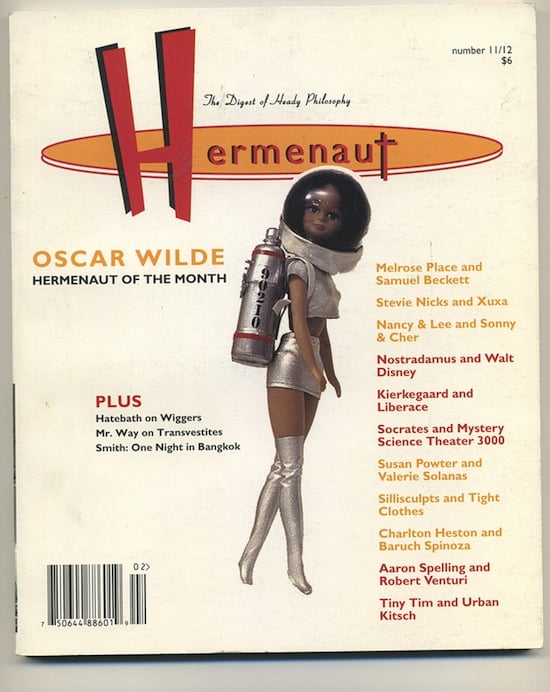
In 1997/1998 Hermenaut went “perfect-bound” (i.e., it had a spine — instead of staples; and the pages were arranged in signatures and glued together in a text block).
Between issue 10 and issue 11/12 I’d moved from Minneapolis to Williamstown, Mass., where I’d taken a job as Editorial Director (eventually, Co-Producer) of a startup dotcom called Tripod. Startups require a lot of focus, so a long stretch went by during which we didn’t bring out a new issue. By the time I was ready to bring out a new Hermenaut, I’d amassed nearly 200 pages worth of material. Hence the “11/12” double-issue designation, and thus the need for perfect binding.

One of the inspirations for Hermenaut’s trim size was the “digest-size” magazine — as an adolescent and teen browsing thrift stores and flea markers, I’d bought dozens of copies of Alfred Hitchcock’s Mystery Magazine, Isaac Asimov’s Science Fiction Magazine, and sf digests like Worlds of If, Analog, and Galaxy. I was also inspired by literary and intellectual “reviews” like Partisan Review, Evergreen Review, and Paris Review. So it was a real thrill to finally slap a perfect binding onto Hermenaut.
Pub. Date: Winter 1997/1998
Theme: Camp, Kitsch, and Cheese
Pages: 190
Print Run: 3,000 copies.
Masthead: Joshua Glenn (Editor), Jennifer Engel (Creative Director), A.S. Hamrah and John Cradock (Contributing Editors), Susan Roe (Managing Editor).
Contents: “Their America” column and “Hatebath’s Mailbag” by Slotcar Hatebath, “The Way of Etiquette” column by Mr. Way, “Travels with Smith” column by Patrick Smith [of the zine Stargreen Review], “The B Side of Paradise” column by Chris Fujiwara, Ingrid Schorr’s celebrity biography review column. “Camp: An Introduction” by Joshua Glenn, “Hermenaut of the Month: Oscar Wilde” by Joshua Glenn, “Apocalypse Already” by Clarke Cooper, “Learning from Miami” by Margaret Blonder, “Leather and Lace: My Closet” by Ernest Pascucci, “Dr. Exstaticus, Master of Irony” by Joshua Glenn, “Semi-Precious Moments” by Al Hoff [of the zine Thrift SCORE], “Nancy & Lee and Sonny & Cher” by Phil Milstein, “Viva Liberace!” by Scot Hacker, “The Irony Age” by Jon Spayde, “I, Robot” by Chris Fujiwara, “Death of a Soul Man” by Heidi Olmack, “Earnestness Goes to Camp” by Jerry Jaguar, “The Art of Being Uncomfortable” by Lisa Carver [of the zine Rollerderby], “Model Urban Communities for Communist Urban Models” by Eric Fredericksen. Plus reviews.
Also! We produced a song, “Porchin’,” by the Minneapolis band The Cosmonauts, and published the single as a flexidisc, which was included with issue 11/12. It was exciting to work with the legendary flexidisc manufacturer Eva-Tone, though they were on the verge of going out of business.
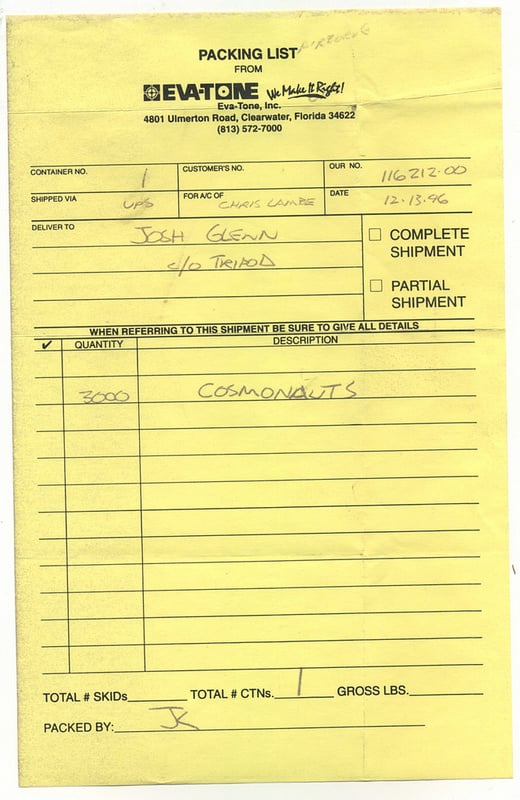
No. 13:
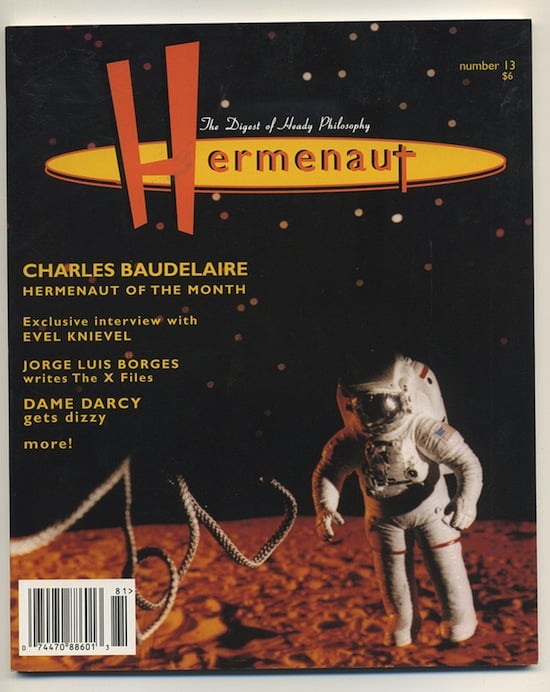
Pub. Date: Summer 1998
Theme: Vertigo
Pages: 104
Print Run: 3,000 copies.
Masthead: Joshua Glenn (Editor), Jennifer Engel (Creative Director); Eric Fredericksen, Jennifer Kabat, Mark Lewman, Marilyn Snell (Board of Advisors).
Contents: “Their America” column by Slotcar Hatebath, Chris Fujiwara’s “The B Side of Paradise” column, Ingrid Schorr’s celebrity biography review column. “Vertigo” introduction by Joshua Glenn, “Hermenaut of the Month: Charles Baudelaire” by Joshua Glenn, “Dizzy Dame” cartoon by Dame Darcy, “Pure Evel” by Dan Reines, “110%” by Karen O’Connor, “Zooming Through Space” by Chris Fujiwara, “Campanile Free-Fall” by John Marr [of the zine Murder Can Be Fun], “Vertigo Changed My Life” by Leslie Harpold [of the webzine Smug], “Vertigo Rush” by Matt Goldberg, “Subvertigo” by Sam Pratt [of the zine Ersatz]. Plus reviews.
No. 14:
By the time this one came out, I’d left Tripod.com and Williamstown. Susan and I moved back to Boston, and I started spending my dotcom money — I had about $80,000 in stock — on Hermenaut. I’d decided to take a shot at turning it into a magazine.
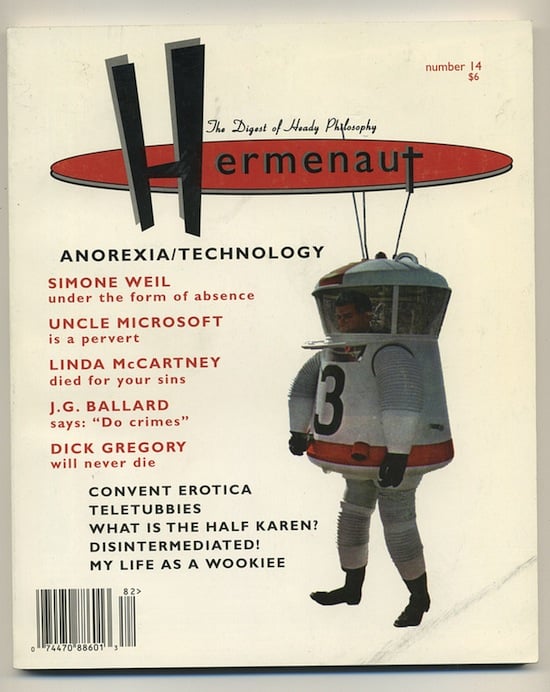
Pub. Date: Winter 1998/1999
Theme: Anorexia/Technology
Pages: 168
Print Run: 4,000 copies.
Masthead: Joshua Glenn (Editor), Jennifer Engel (Creative Director), A.S. Hamrah (Critical Affairs Dept.); Peter Bebergal, Adrienne Campbell-Holt, A.J. Picchione, Dan Reines (Editorial Staff).
Contents: “Anorexia/Technology” introduction by Joshua Glenn, “Their America” column and “Life in Their America” by Slotcar Hatebath, “Letter from London” by Matthew De Abaitua, “Philosophywatch” column, Chris Fujiwara’s “The B Side of Paradise” column, Ingrid Schorr’s celebrity biography review column; “My Life as a Wookiee” by Clarke Cooper, “Death in the Maiden” comic by Dame Darcy, “Hermenaut of the Month: Simone Weil” by Joshua Glenn, “The Half Karen” by A.S. Hamrah, “Interview with an Anorexic” by Lisa Carver [of the zine Rollerderby], “Fun with Richard & Karen” by John Marr [of the zine Murder Can Be Fun], “Extreme Dieting” by Mark Frauenfelder [of the zine Boing Boing], “Confessions of an Anorexic Wannabe” by Michelle Chihara, “100 Best American Movies” by Chris Fujiwara, “Anorexic Outfitters” by Pauline Wolstencroft, “The Juice on Dick Gregory” by Dan Reines, “Disintermediated!” by Chris Fujiwara, “Suffragist City” by Dara Moskowitz, “The Thin Machine” by David Rothenberg, “100 Best Novels” by Chris Fujiwara and A.S. Hamrah, “Thin Code” by Scot Hacker, “Convent Erotica” by Chris Fujiwara. Plus reviews — including “Fatty Fiction” by Lynn Peril [of the zine Mystery Date].
No. 15:
In 1999, Anthony Leone — who’d been creative director of the zine Commodity — joined Hermenaut as Art Director.
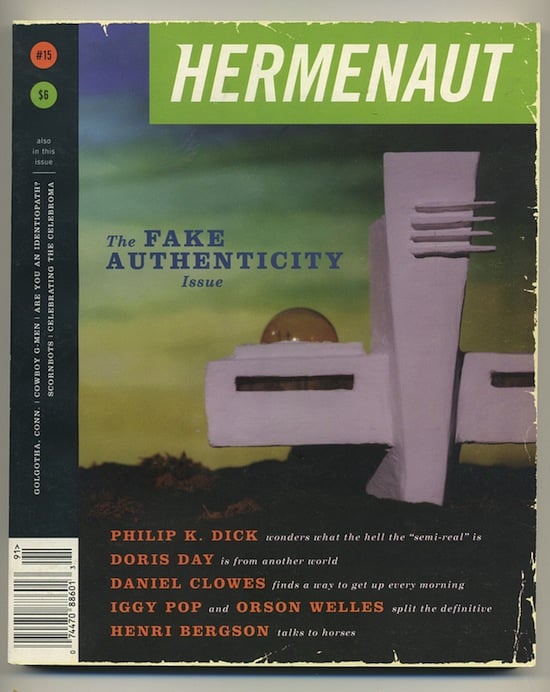
Pub. Date: Summer 1999
Theme: Fake Authenticity
Pages: 232
Print Run: 5,000 copies.
Masthead: Joshua Glenn (Editor), Anthony Leone (Art Director), A.S. Hamrah (Critical Affairs Dept.), Art Editor (Michael Lewy); A.J. Picchione, Dan Reines, Ingrid Schorr (Editorial Staff); Richard Grijalva, Ingrid Schorr (Ad Sales).
Contents: “Their America” column and “Life in Their America” by Slotcar Hatebath, “Letter from LA” by Dan Reines, “I’m Reading as Fast as I Can” celebrity biography review column by Ingrid Schorr, Chris Fujiwara’s “The B Side of Paradise” column, Hap Mansfield’s “Sonic Tollbooth” music review column, James Parker’s “Noisy Parker” music review column. “Fake Authenticity: An Introduction” by Joshua Glenn, “The Will to Scorn” by Clarke Cooper, “Ubik” comic by Dame Darcy, “Hermenaut of the Month: Philip K. Dick” by Joshua Glenn, “Memories of the Biosphere” by Margaret Blonder, “Comoerotic” by Joseph Lanza, “The Green Hills of Elsewhere” by Thomas Frank [of the zine The Baffler], “The Beckett/Bushmiller Letters” by A.S. Hamrah, “An Interview with Daniel Clowes” by Joshua Glenn, “That Darn Drunk!” by Todd Levin [of the webzine Smug], “Saved by Betrayal” by Chris Fujiwara, “How I Stopped Rockin’ with Dokken” by Lisa Carver [of the zine Rollerderby] and David Goolkasian, “Onward Christian Tourists” by Mary E. Ladd and Julie Wiskirchen [of the webzine Ape Culture], “Feel Like a Stranger” by Matt Goldberg, “Identiopathy” by Carl Carbone, “The Mint Condition” by Matthew De Abaitua, “Intimate Televisions” by Ernest Pascucci, “Club Havana redesigns the Money” by Chris Fujiwara and A.S. Hamrah, “Pilgrim’s Progress” by Jessica Hundley, “Debasement by Acclaim” by Clarke Cooper, “Club 9, Pioneer Town” by Marilyn Berlin Snell, “Dear Fuad Ramses” by Chris Fujiwara, “Marlo’s Meiji Masterpiece” by Venus de Malachite, “The Trouble with Trekkers” by Greg Rowland. Plus reviews.
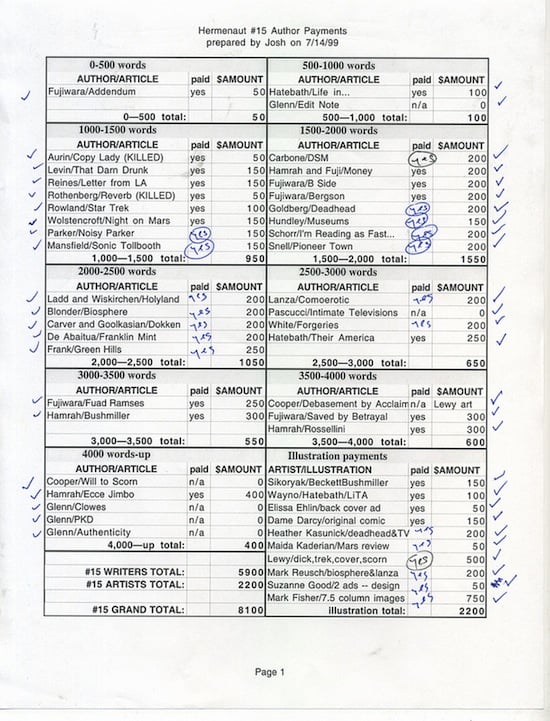
PS: Lingua Franca profiled Hermenaut (rather snarkily) in October 1999. Here’s the profile. Excerpt: “As they contemplate their role as aesthetes in a mass society, the Hermenauts will accept the occasional dribble of ad revenue from university presses. In the most recent issue, one page is split between two advertisements: one for the new edition of Derrida’s Of Grammatology, the other for records by the punk band Fugazi. But Glenn is very clear about Hermenaut’s relation to the university. ‘One of our secret fantasies,’ he confesses, ‘is that students and professors will discover Hermenaut, then drop out. They would see it and think: I can read and think for myself, without a syllabus.’”
Also: The June 19, 2000 issue of The American Prospect compared Hermenaut with The Baffler and David Eggers’s Might.
The early 1990s produced a bumper crop of small-circulation journals uniquely attuned to the cultural moment — that is, the three- or four-year window during which the newsweeklies and chat shows were exchanging one conventional wisdom about Eggers’s twenty-somethings, the slacker/Nirvana/grunge hypothesis, for another, the energetic/can-do/e-generation hypothesis. (For a good illustration, compare Time’s scolding 1990 cover story “Twenty-something” with one from 1997,”Great Xpectations.”) Three in particular stand out today: Eggers’s Might; Hermenaut, founded in Boston by Joshua Glenn in 1992; and the Chicago-based Baffler, which was founded in 1988 by two agnostic grad students named Thomas Frank and Keith White, but seemed to find its voice during the Gen-X craze of the early 1990s. “You wonder about the nature of twenty-somethings?” Frank and White raged in a 1992 essay, aiming at the Boomer media mandarins who were commissioning so much of the drivel. “Here’s your answer: we are twenty-nothing, forever lost to your suburban platitudes, lost to the simple blather of your TV, deaf to your non-politics.”
Each of the three has taken slightly different approach. The Baffler, as may already be obvious, tends to favor polemic (favorite targets: the “alternative” music industry, Fast Company, and Wired). Hermenaut operates as a sort of freelance department of philosophy, minus the jargon and tweed. Might, when it was still around, had a more satiric, prankster sensibility: One memorable article faked the death of child star Adam Rich as a take on celebrity memorial journalism. (There are also a few notable successors: Adbusters does advertising criticism almost as well as The Baffler, and Suck.com’s pseudonymous pamphleteers include many contributors to Hermenaut, Might, and The Baffler.)
But whatever the mode of attack, they all share a sense of the basic problem at hand. Commerce has thoroughly colonized culture; real dissent — cultural, political, artistic — is being replaced by, as Frank once wrote, “soaps that liberate us, soda pops that are emblems of individualism, and counterhegemonic hamburgers” (Or, as Frank & Co. put it in the more overtly political formulation of their 1997 collection, Commodify Your Dissent, “Contemporary capitalism has marshaled the forces of culture, whatever they are, to ensconce itself in power and to insulate itself from criticism to an almost entirely unprecedented extent.”) There is also a sense that consumer culture has achieved a certain apogee with their own generation — the first for whom television, thoroughly embedded in the cultural landscape, has become the chief source for just about every kind of information, art, and entertainment.
Significantly, both The Baffler and Hermenaut, founded by refugees from academe, aim specifically at resuscitating generalism. Academic-style criticism — with its hyperspecialization, obsession with theory, and love of relativism — is not only conspicuously absent from their pages, but conspicuously maligned. Their writers aim for accessibility and, within the confines of somewhat erratic publishing schedules, some kind of topicality. Like most people of a certain age, they tend to be intimate with the mundanery of American pop culture, comfortably situated in its mutterings even while criticizing it ferociously. There is plenty of irony to go around, of course, but it is the redemptive kind: a means, not an end, a pair of X-ray glasses, a way of filtering out distractions and homing in on what is real.
No. 16:
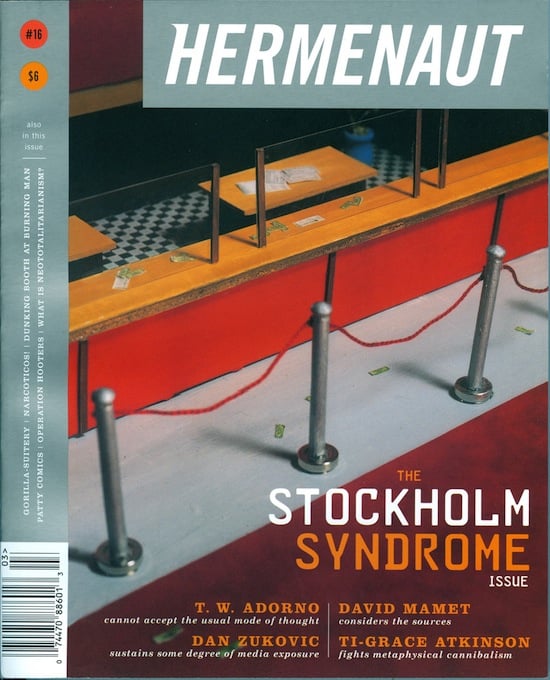
Pub. Date: Winter 2000/2001
Theme: Stockholm Syndrome
Pages: 208
Print Run: 10,000 copies.
Masthead: Joshua Glenn (Editor), Anthony Leone (Art Director), A.S. Hamrah (Critical Affairs Dept.), Carrie Ingoglia (Managing Editor), Michael Lewy (Art Editor), Laurie Glenn and Tara Koelbl (Editorial), Richard Grijalva (Ad Sales). Contributing Editors: Clarke Cooper, Matthew De Abaitua, Chris Fujiwara, James Parker, Dan Reines, and Ingrid Schorr.
Contents: “Their America” column by Slotcar Hatebath, “I’m Reading as Fast as I Can” celebrity biography review column by Ingrid Schorr, Chris Fujiwara’s “The B Side of Paradise” column, James Parker’s “Noisy Parker” music review column. “The Price is Right” comic by R. Sikoryak and A.S. Hamrah, “Village of the Damned” comic by Dame Darcy, “The Origins of Neototalitarianism” by Clarke Cooper, “Triumph of the Pep” by Melissa Dogwater, “Strange, Beautiful, Revolutionary: Ti-Grace Atkinson” by Lynn Peril [of the zine Mystery Date], “Hermenaut of the Month: T.W. Adorno” by Joshua Glenn, “The Lunch Problem” by Keith Gessen, “Dear Teddie” by Joshua Glenn and A.S. Hamrah, “Swedish Bank Job” by John Marr [of the zine Murder Can Be Fun], “Patty Comics” comic by R. Sikoryak and A.S. Hamrah, “Buffalo Wings of Desire” by Jen Collins and Dan Reines, “The Utter Sameness of Everything: An Interview with Dan Zukovic” by Joshua Glenn and A.S. Hamrah, “The Force of the Useless” by Chris Fujiwara, “Jump Into the Beam” by Louis Theroux, “This World Is Killing You” by Scott Farrin, “Is This Seat Taken?” by Beth Daniels, “Daniel Boone Was a Man” by T.R. Johnson, “I, Tania” by Ingrid Schorr, “The Vancouver Syndrome” by Joseph Lanza, “FCUK Them All” by Matthew De Abaitua, “The Perly Gates” by Lydia Millet, “Dunking Booth at Burning Man” by various contributors (edited by A.S. Hamrah), except from Wilson: A Consideration of the Sources by David Mamet, “The Dreamlife of the Zombies of Mora Tau” by Chris Fujiwara, “The Guy in the Gorilla Suit” by Gavin McNett, “Porno for Philos” by Michael Bowen. Plus reviews by Chris Fujiwara, Paul Maliszewski, and Sam Lipsyte.
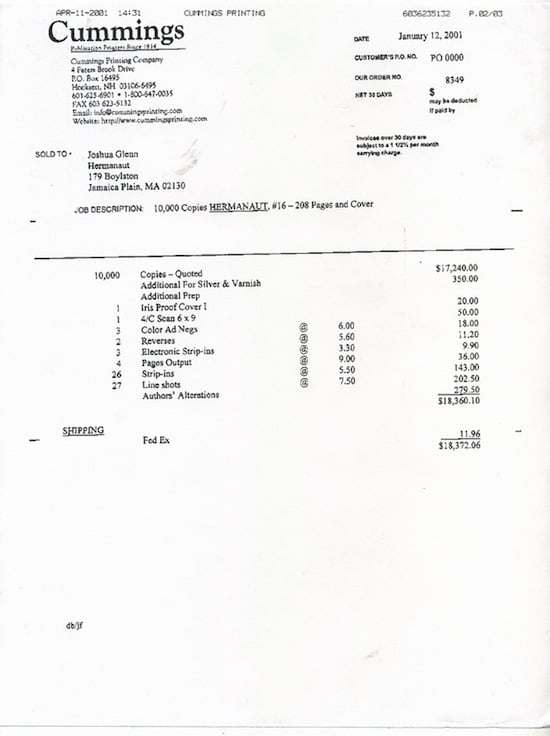
PS: I’ve written briefly about the demise of Hermenaut in an essay, for the journal n+1, on the topic of what I call the “Argonaut Folly.”
Tony Leone brought a number of terrific illustrators to Hermenaut — including his fellow MassArt alumni Michael Lewy, Mister Reusch, and Heather Kasunick. Not coincidentally, Tony and Michael have recently been responsible for the design and illustration of the Radium Age Science Fiction series from HiLoBooks; and Tony, Mister Reusch, and Heather are responsible for the design and illustration of my family activities book UNBORED and its forthcoming spinoffs.

Also, you may have noted that a few of Hermenaut’s contributors now write for HiLobrow (e.g., Matthew Battles [who wrote for Hermenaut.com], Jerrold Freitag, Katie Hennessey, Mimi Lipson, James Parker, Lynn Peril, Dan Reines, Greg Rowland, Marilyn Snell). Hermenaut contributors have also made appearances in my books Taking Things Seriously (Marilyn Snell, Lisa Carver, Tom Frank, Jen Collins, A.S. Hamrah, Patrick Smith, Matthew Battles, Chris Fujiwara, Mimi Lipson, Clarke Cooper, Ingrid Schorr, Heather Kasunick, Lynn Peril, Michael Lewy, Tony Leone, Lydia Millet) and Significant Objects (Matthew Battles, Matthew De Abaitua, Mark Frauenfelder, Jonathan Lethem, Todd Levin, Mimi Lipson, Lydia Millet, James Parker, Dan Reines, Greg Rowland).
What I’m trying to say is: Hermenaut never ended! Instead, it has assumed myriad new forms.
This is a 25-part series in which HiLobrow editor Joshua Glenn, who from 1990–93 published the zine Luvboat Earth and from 1992–2001 published the zine/journal Hermenaut, bids a fond farewell to his noteworthy collection of zines, which he recently donated to the University of Iowa Library’s zine and amateur press collection. CLICK HERE to view the online finding aid for this collection.
